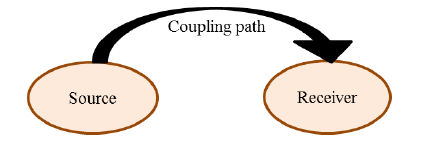Balanced cable has both coax shields grounded at pin 1 on each end. The shunt is from pin 1 to pin 1 parallel to the coax
I reference the Clearer Audio Silverline Optimus 75 ohm digital cable which to date was the best 75 ohm cable I've had in my system until today!
The balanced cable was made by my Bell Labs friend he has the raw coax made for him
Unfortunately with my Bell Labs friends we don't deal with Audio frequencies but much higher ones (up to 175 GHz).
Well the shunt seems to act as a current loop with shield (return path):
- The return current will usually take the path of least impedance
- At low frequencies, this path will depend on the resistance characteristic of the structure.
- At high frequencies the impedance characteristics are dominated by inductances.
- At very high frequencies, also stray capacitances may play a role.
- Mother Nature sets up the return path in order to obtain the lowest possible impedance for the pair.
I am adding a few generalities hereunder. For sure it will not tell if one will improve or not one's listenning experience,
In principle a coaxial cable has to be connected at both ends to ground/chassis:
Frankly speaking i did not understand the JSS's solution with shield + shunt not connected to ground/chassis.
In terms of EM fields the dominant propagation mode is TEM.
It means that the physical Transmission Line (cable) can be modeled by an equivalent
Electrical circuit.
A typical field distribution at a certain instant of time for the crosssection of two interconnects (two-wire and co-axial cable):
The electromagnetic environment is composed of both radiated and
conducted energy. EMC, therefore, has two aspects, emission, and susceptibility. Susceptibility is
the capability of a device or circuit to respond to unwanted electromagnetic energy (i.e., noise). The
opposite of susceptibility is radiation. The immunity level of a circuit or device is the
electromagnetic environment in which the equipment can operate satisfactorily, without
degradation, and with a defined margin of safety. One difficulty in determining immunity (or
susceptibility) levels is defining what constitutes performance degradation. Emission pertains to the
interference-causing potential of a product. The purpose of controlling emissions is to limit the
electromagnetic energy emitted and thereby to control the electromagnetic environment in which
other products must operate. The three aspects, which forms the basic framework of EMC design is
the generation, transmission, and reception of electromagnetic energy.
Whether the source or receptor is intended or unintended depends on the type of the coupling path
and the source or receiver.
The transfer of electromagnetic energy can be divided into four subgroups, radiated emissions,
radiated susceptibility, conducted emissions and conducted susceptibility. These four aspects are
shown in Figure hereunder. An electronic system normally consists of one or more subsystems that
communicate each other via cables. These cables have the potential in emitting or picking up the
electromagnetic energy. Longer the length of the cable, the more efficient it is in picking up or
emitting the electromagnetic radiations. The factor that produces intended or unintended radiation is
the currents on the cables or traces. Electromagnetic emission or susceptibility to emission not only
occurs by radiation through the air, but also interference signals passes between the subsystems
directly via conduction.
































